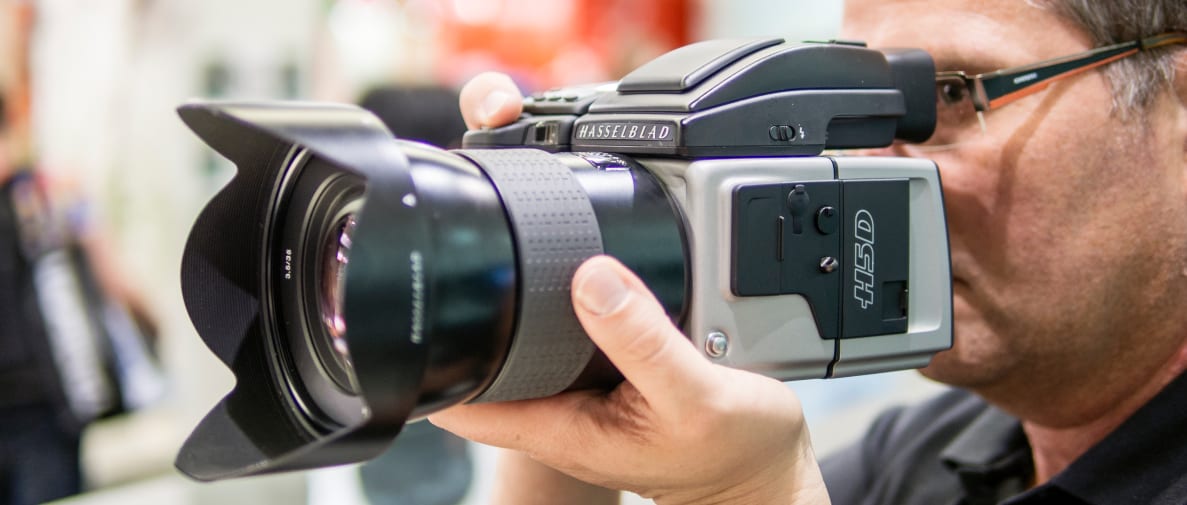But the company has also made its name among fashion photographers and commercial photographers because it offered digital backs for V-system film cameras that date back as far as 1957. This produced huge digital files for photographers doing large prints. Over 50 years later, Hassleblad is making entire systems instead of just add-ons to old film cameras.
Here in 2014, Hasselblad announced the H5D-50c (MSRP $27,500), causing quite a buzz with the company's first CMOS camera. Now Hasselblad has a new back for the H5D: a 50c with WiFi. The new back will have the same 50MP CMOS sensor as the original, plus a few other modern conveniences... like WiFi.
Details about pricing are still unclear, but the new back is scheduled for release in November 2014. For a limited time between January and March 2015, Hasselblad is offering a $1000 upgrade opportunity to existing H5D-50c owners.
We headed to the Hasselblad booth at Photokina 2014, to find out more about what tricks the new 50c has up its sleeve.
Features
50c with WiFi has WiFi... and more.
First off, let's talk about the features that Hasselblad is adding to this new back and why it's worth the upgrade. Keep in mind that many of these features are not on high-end studio cameras like the H5D.
The most obvious addition is the WiFi. This allows users to connect using the Hasselblad Phocus app–on your iPhone or iPad–directly to the camera. This gives you the ability to control the camera—and even browse images—remotely.

WiFi is the big addition on the "H5D-50C with WiFi." It even made its way into the name.
Live View was added to the new back, giving the option of seeing a live image on the rear LCD. This might seem like an obvious omission from previous backs, but most H5D-50c users would have been in a studio, tethered to an external display to view live images. Now, the H5D is a bit more portable, showing not just live view, but ISO and white balance settings on the rear display.
In addition to the default display settings, there are a few different display modes available, including an built-in electronic spirit level, which can be used even when the camera is tethered.

The rear monitor on the H5D-50C is a 3-inch 24-bit color LCD with 460,320 pixels.
Capture rate was increased to enable the H5D-50c to capture 50 frames per minute. This might sound like a decrease in speed, but the previous H5D-50c couldn't buffer the images fast enough, shooting at 1.5fps, then slowing down significantly. That meant that the effective continuous shot rate was actually only 35 images per minute. The 50c with WiFi has an increased buffer, and it definitely feels better to have a steady, 50-frames-per-minute rate.
Hasselblad has also more than doubled the longest exposure time. It has gone from merely 12 minutes to 34 minutes, with no extra black exposure necessary.

A pop-up flash does seem a bit strange for a camera as high-end as the H5D-50C, but why not?
And let's not forget the firmware update. New firmware makes the H5D compatible with film backs. You heard me right... Hasselblad has gone full circle from digital backs for film cameras to film backs on digital cameras. Hasselblad claims this was due to customer demand for film backs on digital bodies. We'd love to meet these people.
Design & Usability
The H5D-50c remains unchanged with the introduction of the new 50c with WiFi back design-wise. It's simply a module that you swap out for your old 50c digital back—"plug-and-play," if you will.
We did handle the H5D-50c quite extensively, since–despite our best efforts–it's not every day that we get to play with $28,500 camera systems. While we're mentioning the price, let's put in perspective how much that is. You can buy a new 2014 Honda Civic (THAT IS A CAR!) or you could pay for all 4 years of in-state tuition to the University of Florida.
Now that we have that off our chest, let's talk about what kind of handling you'll get for that money. In short: not the best. That isn't because the design is terrible, but because the camera is so large that it's impossible for it to be comfortable for more than a short stint.
It's worth noting that, though WiFi and Live View might make the H5D more portable, this is still a camera you're going to want on a tripod.

Make sure you eat your Wheaties if you want to wield this monster camera.
The grip is a huge, pistol style handle that's capable of supporting the body with one hand–as long as you don't have something like this on the camera. Trust me, I put the HC 300mm f/4.5 on the H5D-50c and nearly dropped it. (That would've been an awkward situation.)

The grip on the H5D-50C helps wield its bulk quite well.
The aperture and shutter controls are easy enough to use, as it has dedicated wheels for each on the grip. However, other controls are not quite as easy to get to as on a typical DSLR. Most require you to bring your left hand over to click and select.
The shutter release button is a bit soft while half pressed, but nothing too distracting. The distraction comes from the huge jolt of the leaf shutter when you actually take a photo. Most medium format users would be familiar, but mirrorless cameras are spoiling us these days.
{{ photo_gallery name="New Gallery" }}
Operating the playback is a bit stiff. When you zoom in on an image and start to move left or right with the directional pad, it moves with a shutter type motion that isn't smooth. This was a bit surprising, but you aren't going to get much information about a 50MP image on a 3-inch LCD anyway, so you should probably upload them to take a closer look. The playback does work well enough to check focus and exposure.
Using the menu, which is located on the upper screen instead of the rear LCD, is a lot like being in a GoPro menu. You can flip through and change settings, so it does its job, but it's not very impressive for a $28k camera.

The top controls on the H5D-50C have all the shortcuts you need to manage exposure and quality.
All of this said, these kind of cameras are not built to be the most comfortable or even user friendly. They are made for very serious photographers that want the best performance or the largest file sizes for print. Complaining about the comfort and user-friendliness of a system like this is like complaining about a Formula One car being uncomfortable during the Dakar Rally.
Conclusion
Hasselblad get a little more modern.
In the end, the H5D-50c is a camera for the 1% of photographers out there that actually need and have the cash for this kind of tool. It is not something you can find at Best Buy or Target–what a strange world that would be.

The H5D-50C has a 50MP CMOS sensor.
If you are part of the 1% and you're reading this review wondering if the new H5D-50c is worth the extra $1000 investment–it absolutely is. If you've already spent the $27,500 to get the WiFi-less version, you'll get more than your money's worth dropping the $1000 for increased capture rate alone, not to mention increased exposure time, WiFi, live view, and more.
We would like to say that we'll be bringing you the full review on the H5D-50c as soon as we get it into our labs, but we aren't part of the 1% of the photographers that need and have the cash for this. If anyone has an H5D-50c lying around and wants to loan it to us, we would gladly put it through the paces so you know what you've invested in.
Meet the tester
As a photojournalist, Jackson has had stints working with bands, the military, and professional baseball teams before landing with Reviewed. Outside of Reviewed, he can be found looking for the next game to relieve his "Gamer ADD" or growing his beard.
Checking our work.
Our team is here for one purpose: to help you buy the best stuff and love what you own. Our writers, editors, and lab technicians obsess over the products we cover to make sure you're confident and satisfied. Have a different opinion about something we recommend? Email us and we'll compare notes.
Shoot us an email


